

Questions to Help in Creating Characters. Creating the more complex round characters takes time -- time spent thinking about how your characters look, where they're from, and what motivates them, for instance.
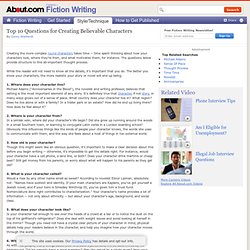
The questions below provide structure to this all-important thought process. While the reader will not need to know all the details, it's important that you do. The better you know your characters, the more realistic your story or novel will end up being. 1. Where does your character live? Michael Adams ("Anniversaries in the Blood"), the novelist and writing professor, believes that setting is the most important element of any story. 2.
In a similar vein, where did your character's life begin? 3. Though this might seem like an obvious question, it's important to make a clear decision about this before you begin writing -- otherwise, it's impossible to get the details right. 4. Would a rose by any other name smell as sweet? Creating an Original Character. By Maisha Foster-O'Neal You've heard the old maxim before...
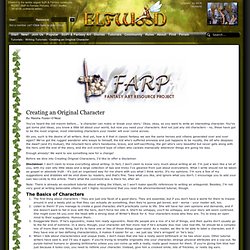
Fiction Writer's Character Chart - EpiGuide.com. If you're a fiction writer -- whether you're working on a novel, short story, screenplay, television series, play, web series, webserial, or blog-based fiction -- your characters should come alive for your reader or audience. The highly detailed chart below will help writers develop fictional characters who are believable, captivating, and unique. Print this page to complete the form for each main character you create. Creat a Character Exercises. Getting to Know your Characters Create a character or get to know him better with these creative writing exercises.

Well written characters engage the reader and make him feel as though he has made a new friend. 100 Character Development Questions for Writers. Setting of a story — The Writer’s Craft. The following exercises will allow you to create a rich, vibrant setting of a story, giving the reader the full vicarious experience. 1.
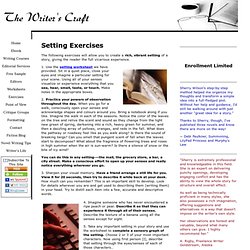
Use the setting worksheet we have provided. First Person Point of View — The Writer’s Craft. When you tell a story through a viewpoint character using I or we, you are using first person point of view.
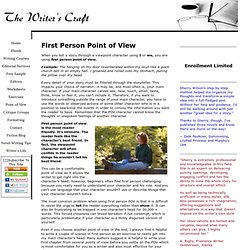
Example: The banging on my door reverberated within my skull like a giant church bell in an empty hall. I groaned and rolled onto my stomach, pulling the pillow over my head. Every detail of your story must be filtered through the storyteller. Perspectives — The Writer’s Craft. In order to fully understand point of view in literature, we need to explore the different perspectives from which a story may be told.
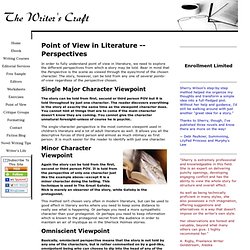
Bear in mind that the Perspective is the scene as viewed through the eyes/mind of the chosen character. The story, however, can be told from any one of several points-of-view regardless of the perspective chosen. Single Major Character Viewpoint The story can be told from first, second or third person POV but it is told throughout by just one character. Omniscient Person Point of View — The Writer’s Craft. Basically, omniscient point of view means that the story is told from an all-seeing God-like, omnipotent viewpoint.

You would use third person pronouns in the writing, but you can choose to dip into the head of any of the characters and reveal things that have occurred in the past or will happen in the future. This was once a very popular method of storytelling. It is less so now, especially in the North American market. Still there are some cases where this can add extra dimension to your writing when done well. Other - How to Create Realistic and Believable Characters. How to Create Realistic and Believable Characters 1. Before you think of your character, you need to think of your character's purpose. Is their purpose to hinder your character? Help him? Is he the main character? Character Development: Creative Writing. Print version Characters are the most important component of any narrative.
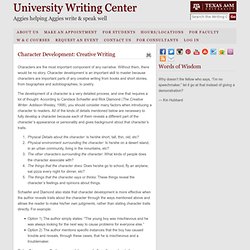
Without them, there would be no story. Character development is an important skill to master because characters are important parts of any creative writing from books and short stories, from biographies and autobiographies, to poetry. Top 10 Tricks to Make your Villain Stand Out. Welcome back to the column that breaks down gaming into what’s really important, ten things at a time!
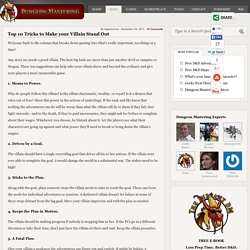
Any story arc needs a good villain. The best big bads are more than just another devil or vampire or dragon. These ten suggestions can help take your villain above and beyond the ordinary and give your players a more memorable game. How to Create a Character. By Holly Lisle All Rights Reserved No matter what sort of fiction you’re writing, you’re going to have to populate your story with characters, and a lot of them, if not all of them, you’re going to have to create from scratch.

Unfortunately — or maybe fortunately — there is no Betty Crocker Instant Character-In-A-Can that you can mix with water and pop into the oven for twenty minutes. There aren’t any quick and easy recipes, and I don’t have one either, but I do have some things that have worked for me when creating my characters, and some things that haven’t. Random Name Generator. Naque's Word Mixer » unique-names.com.